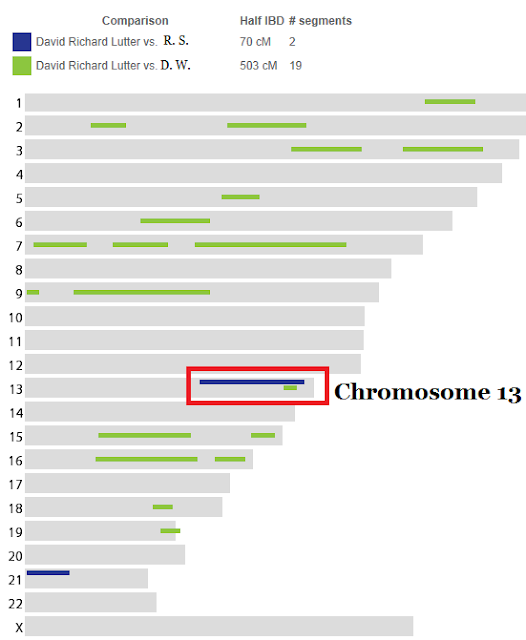 |
| Family Tree Maker 2012 |
In the family tree above, orange represents the inheritance path shared by my father and his paternal first cousin once removed, D. W. The purple represents the inheritance path shared by my father and his maternal third cousin, R. S. They are related one more generation back to Calvin Cook and Mary Neil.
At this time, my father and these two cousins have tested their DNA at 23andMe. The key to figuring out your matches is to test family members from different branches of your tree.
My father matches both R. S. and D. W. on the same area of Chromosome 13. You have two sides to each of your autosomes-22 of your 23 chromosomes. [The 23rd pair is the sex chromosomes and they are inherited differently.] One side is from your mother, the other side from your father. Current DNA analysis that we are using for genealogy is not able to report which side of the chromosome is being read. Instead, the matches for both sides are mixed together, making it very hard to distinguish your paternal matches from your maternal matches. My father has Colonial American ancestry on both his paternal and maternal sides, making it difficult to decide which of his parent's trees we should look to for the common ancestor.
 |
| 23andMe DNA comparison My father versus his third cousin and his first cousin once removed. The area of focus for this discussion is Chromosome 13. |
Now that I have both cousins matching in the same area, I can look for matches in the database who match my father on this same area of Chromosome 13 and compare them against the known cousins.
Using R. S. as a guiding point, as he shares the largest segment with my father in this area of Chromosome 13, we find that J. G. and P. J. J. also match my father on this area of Chromosome 13. Note that where one chromosome breaks, the other starts. I find this quite often in the matches.
We compare these matches to R. S. This will represent our test to see if they match on my father's mother's side, specifically the Cook/Neil branch.
P. J. J. and J. G. do not match my father's maternal third cousin. This is not conclusive proof that they do not match, as errors occur in testing and slight mutations occur in every generation.
We have to try the other option, that P. J. J. and J. G. match through my father's father, Clifford Lutter. So we look at the ancestry of my paternal grandfather. His mother, Laura Winterton, was of Colonial American extraction. His father, Howard Lutter, was of entirely German descent.
Distant genetic cousin J. G. was born in the United States and has heavy German ancestry. One of his ancestral names looks a lot like one of my ancestral names in this branch of my tree. We are unable to find a common ancestor in our trees at this time, but I would like to place J. G. in the Lutter/Uhl branch.
P. J. J. has very limited access to her ancestral tree, more of a blank slate. I actually find unknown ancestries easier to work with because they have no preconceived notions of who and where their ancestors were. Based on the break in the DNA segment, my hypothesis was that P. J. J. matched through my father's paternal grandmother, or the Winterton/Dunn branch. When I tested my cousin D. W. of the Winterton/Dunn branch, my hypothesis was that he would match P. J. J. but not J. G.
Here's the comparison.
If I can identify more genetic matches in either branch, we can establish more common matches and be more certain that we are assembling the genetic trees accurately.
If any of my fellow 23andMe users have any advice on utilizing both close cousins, please let me know. Thank you.



No comments:
Post a Comment